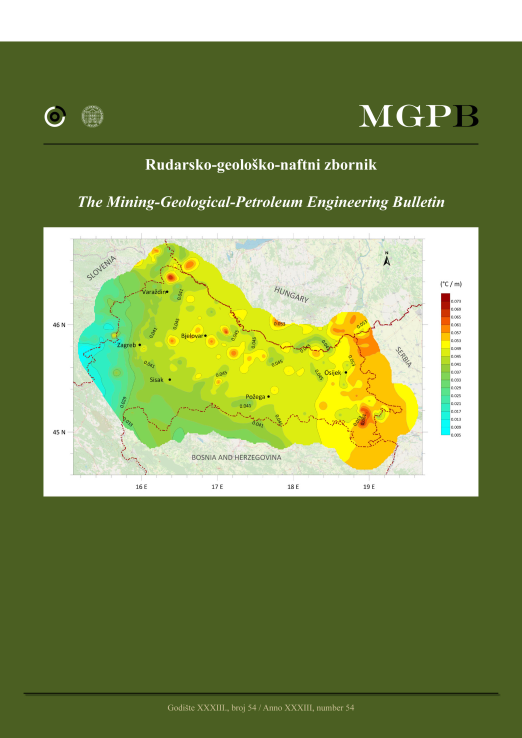Two-component fluid front tracking in fault zone and discontinuity with permeability heterogeneity
DOI:
https://doi.org/10.17794/rgn.2021.3.2Keywords:
discontinuity, fault, Lattice Boltzmann method, fluid front, streamlineAbstract
Fluid front tracking is important in two-phase/component fluid flow in porous media with different heterogeneities, especially in the improved recovery of oil. Three different flow patterns of stable, viscous fingering, and capillary fingering exist based on the fluids’ viscosity and capillary number (CA). In addition, fluid front and sweep efficiency are affected by the heterogeneity of the porous medium. In the current study, the heterogeneous porous media are: (1) normal fault zone or cross-bedding with heterogeneity in permeability, and (2) a fracture or discontinuity between two porous media consisting of two homogeneous layers with very low and high permeabilities, in which immiscible water flooding is performed for sweep efficiency and streamlines tracking purposes. By considering the experimental glass micromodel and the simulation results of discontinuity, a crack is the main fluid flow path. After the breakthrough, fluid inclines to penetrate the fine and coarse grains around the crack. Moreover, an increase in flow rate from 1 and 200 (ml/h) in both the experimental and simulation models causes a reduction in the sweep efficiency from 14% to 7.3% and 15.6% to 10% by the moment of breakthrough, respectively. In the fault zone, the sweep efficiency and the streamline of the injected fluid showed a dependency on the interface incident angle, and the layers’ permeability. The presented glass micromodel and Lattice Boltzmann Method were consistent with fluid dynamics, and both of them were suitable for a precise evaluation of sweep efficiency and visualization of preferential pathway of fluid flow through cross-bedding and discontinuity for enhanced oil recovery purposes.
Downloads
Published
How to Cite
Issue
Section
License
Copyright (c) 2021 authors and journal

This work is licensed under a Creative Commons Attribution 4.0 International License.
Creative Commons-BY
Authors who publish with this journal agree to the following terms:
In agreeing this form, you certify that:
- You read the ethical codex of the RGN zbornik available at journal web.
- You submitted work is your original work, and has not previously been published and does not include any form of plagiarism.
- You own copyright in the submitted work, and are therefore permitted to assign the licence to publish to RGN zbornik.
- Your submitted work contains no violation of any existing copyright or other third party right or any material of an obscene, libellous or otherwise unlawful nature.
- You have obtained permission for and acknowledged the source of any illustrations, diagrams or other material included in the work of which you are not the copyright owner.
- You have taken due care to ensure the accuracy of the work, and that, to the best of your knowledge, there are no false statements made within it.
- All co-authors of this submitted work are aware of, and in agreement with, the terms of this licence and that the submitted manuscript has been approved by these authors.
Publication licence
You retain copyright in your submitted work, according to journal license policy (CC-BY). By signing this form you agree that RGN zbornik may publish it under the publication licence. In summary the licence allows the following:
Anyone is free:
- To copy, distribute, display, and perform the work.
- To make derivative works.
Under the following conditions:
- The original author must always be given credit.
- The work may not be used for commercial purposes.
- If the work is altered, transformed, or built upon, the resulting work may only be distributed under a licence identical to this one.
Exceptions to the licence
In addition to publishing the work printed under the above licence, RGN zbornik will also enable the work to be visible online.
The journal editorial can change the licence rules anytime but it cannot retroactively restrict author(s) rights.


